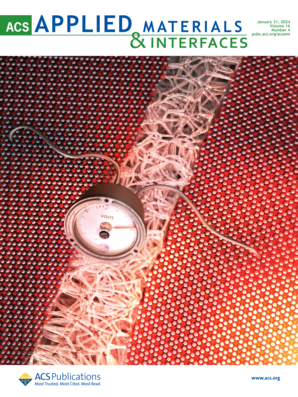纤维素阴极间层聚合优化实现高性能有机太阳能电池
IF 8.3
2区 材料科学
Q1 MATERIALS SCIENCE, MULTIDISCIPLINARY
引用次数: 0
摘要
在高性能有机太阳能电池(OSCs)的发展中,调节小分子阴极间层(CIL)材料的聚集和分子堆积是一个重要但不易被忽视的问题。对于著名的PDINN小分子,苝二亚胺分子骨架的强聚集倾向导致成膜时结晶度过高,最终影响了膜的形态和电荷输运能力。在这里,我们通过在PDINN溶液中引入适量的羟丙基纤维素(HPC)来开发羟基诱导的抗聚集策略来解决这个问题,并在成膜质量和材料聚集之间取得了谨慎的平衡。以两种市售有源层系统PM6/Y6和D18/L8-BO为例,HPC的引入显著提高了器件的JSC和FF值。因此,PM6/Y6系统的功率转换效率从17.38%提高到18.25%,D18/L8-BO系统的功率转换效率从18.45%提高到19.73%,证明了HPC混合界面的厚度公差得到了显著提高。这种羟基诱导的抗聚集策略已经在其他活性层体系中证明了效率。本工作为解决小分子硅溶胶材料的聚集问题提供了一种简单有效的方法,有利于硅溶胶的商业化开发。本文章由计算机程序翻译,如有差异,请以英文原文为准。

Aggregation Optimization of Cathode Interlayer via Incorporating Cellulose Enables High-Performance Organic Solar Cells
Regulating aggregation and molecular packing of small-molecule cathode interlayer (CIL) materials is a significant but imperceptible issue in the development of high-performance organic solar cells (OSCs). For the celebrity PDINN small molecule, the strong aggregation tendency of the perylene diimide molecular backbone leads to excessive crystallinity when films form, ultimately affecting the morphology and charge transport ability of the films. Herein, we address this issue by developing a hydroxyl-induced anti-aggregation strategy by introducing a suitable amount of hydroxypropyl cellulose (HPC) into the solution of PDINN, and a careful balance is achieved between the film-forming quality and the aggregation of the material. Taking two commercially available active layer systems, PM6/Y6 and D18/L8-BO, as examples, the introduction of HPC significantly increases the JSC and FF values of the devices. Therefore, power conversion efficiency risen from 17.38% to 18.25% for the PM6/Y6 system and from 18.45% to 19.73% for the D18/L8-BO system, and it was proved that the thickness tolerance of the HPC hybrid interface was improved significantly. This hydroxyl-induced anti-aggregation strategy has demonstrated efficiency in other active layer systems. This work provides a simple and effective method to solve the aggregation problem of small molecule CIL materials, which is conducive to the commercial development of OSCs.
求助全文
通过发布文献求助,成功后即可免费获取论文全文。
去求助
来源期刊

ACS Applied Materials & Interfaces
工程技术-材料科学:综合
CiteScore
16.00
自引率
6.30%
发文量
4978
审稿时长
1.8 months
期刊介绍:
ACS Applied Materials & Interfaces is a leading interdisciplinary journal that brings together chemists, engineers, physicists, and biologists to explore the development and utilization of newly-discovered materials and interfacial processes for specific applications. Our journal has experienced remarkable growth since its establishment in 2009, both in terms of the number of articles published and the impact of the research showcased. We are proud to foster a truly global community, with the majority of published articles originating from outside the United States, reflecting the rapid growth of applied research worldwide.
 求助内容:
求助内容: 应助结果提醒方式:
应助结果提醒方式:


